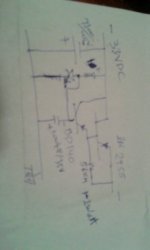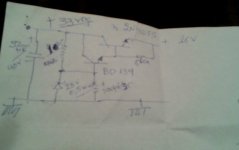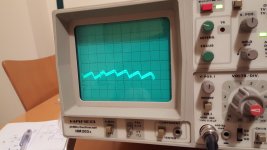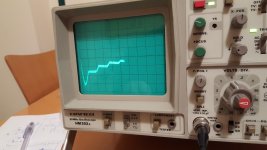Ok so I tested the amp with a 12vdc power supply and it worked fine. no hum or anything. we even listened to a bit of music.
My friend had an oscilloscope and we managed to "see" the hum.
We also built two stabilizing circuits as in the pictures attached and used the original transformer. we removed the bridge from the board and soldered it with tow extra 3300 capacitors. that way we had only stabilized dc voltage going to the pcb. but the hum was still there.
when we put the whole assembly on the oscilloscope we noticed something weird with the bridge rectifier. As in the pictures attached the positive and negative output of the bridge is different. So we thought that something might be wrong with the bridge. After changing the bridge the hum is still there.
I know the pictures aren't of the best quality but its the best I can do at the moment.
My friend had an oscilloscope and we managed to "see" the hum.
We also built two stabilizing circuits as in the pictures attached and used the original transformer. we removed the bridge from the board and soldered it with tow extra 3300 capacitors. that way we had only stabilized dc voltage going to the pcb. but the hum was still there.
when we put the whole assembly on the oscilloscope we noticed something weird with the bridge rectifier. As in the pictures attached the positive and negative output of the bridge is different. So we thought that something might be wrong with the bridge. After changing the bridge the hum is still there.
I know the pictures aren't of the best quality but its the best I can do at the moment.
Attachments
The +ve ripple looks fairly normal from peak to peak. What value is that reading?
The ripple on the power supply is very "thick",
Is that thickness made up from a very fast oscillation?
I also see an intermittant break up, that looks like interference.
Can you get that interference to disappear by switching off all nearby fluorescent ligts and LED lights and soldering station and anything else that has switching PSU?
The -ve ripple looks weird.
The ripple on the power supply is very "thick",
Is that thickness made up from a very fast oscillation?
I also see an intermittant break up, that looks like interference.
Can you get that interference to disappear by switching off all nearby fluorescent ligts and LED lights and soldering station and anything else that has switching PSU?
The -ve ripple looks weird.
Last edited:
The +ve ripple looks fairly normal from peak to peak. What value is that reading?
The ripple on the power supply is very "thick",
Is that thickness made up from a very fast oscillation?
I also see an intermittant break up, that looks like interference.
Can you get that interference to disappear by switching off all nearby fluorescent ligts and LED lights and soldering station and anything else that has switching PSU?
The -ve ripple looks weird.
the thickness is due to the oscillation. I didn't bother to adjust it and make it look better before taking the pictures unfortunately.
both pictures are at 0.5volt/div as you can see from the knob on the right. I dont remember the exact voltage. But both pictures are taken at the bridge (before the two extra circuits I built) If I'm not mistaken. I guess its around 33volts? not sure though
I cant recall which picture is from the positive and which from the negative of the bridge. But the first picture is ok, my problem is with the second picture.
in the second picture there is that drop that I think is the problem.
I changed the bridge with a new one but I wasn't at my friend's to see what's going on with the oscilloscope. I'll visit him again this Saturday probably and look more into it.
I'll try removing the bridge and putting a diode rectifier and see if anything changes.
Is that trace the ripple on the PSU, or is it the output of the amplifier?
It's on the PSU
It should not be oscillating.
Remove the regulator.
Test the transformer alone.
add on the rectifier.
Test that assembly.
Add on the smoothing capacitors
Test that assembly.
Remove the regulator.
Test the transformer alone.
add on the rectifier.
Test that assembly.
Add on the smoothing capacitors
Test that assembly.
It should not be oscillating.
Remove the regulator.
Test the transformer alone.
add on the rectifier.
Test that assembly.
Add on the smoothing capacitors
Test that assembly.
Ok, will do
- Status
- Not open for further replies.
- Home
- Amplifiers
- Chip Amps
- LM3886 hum



